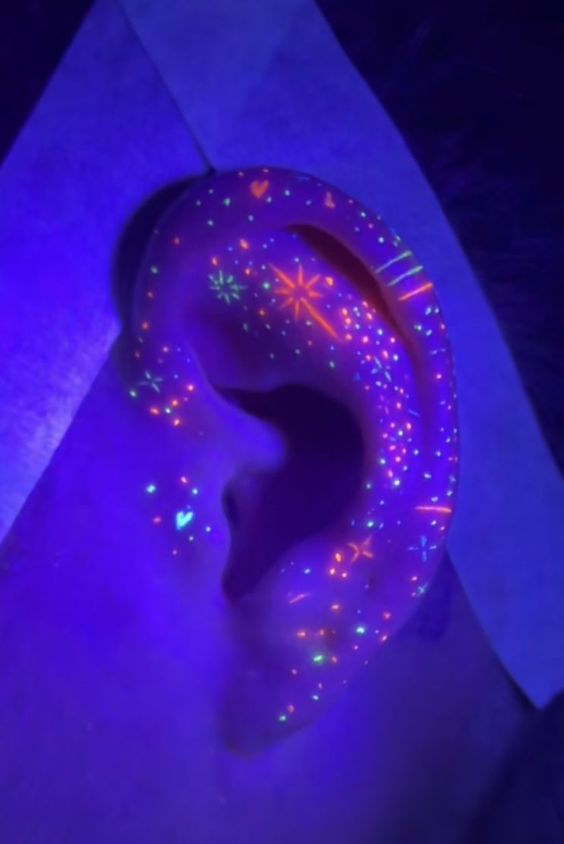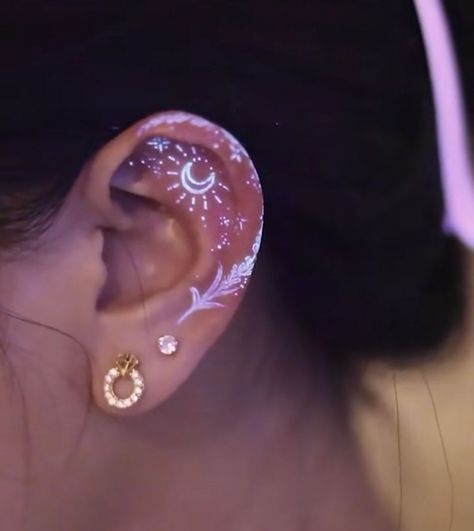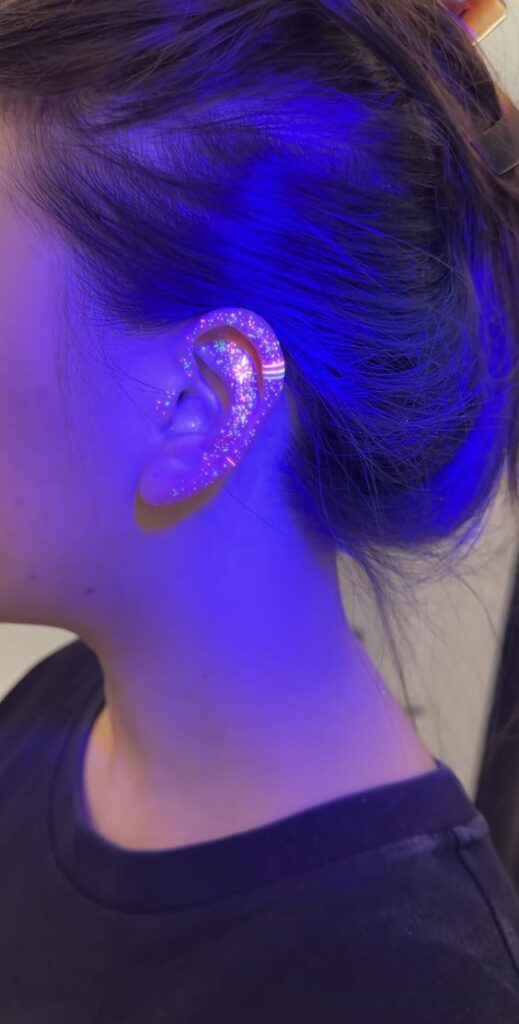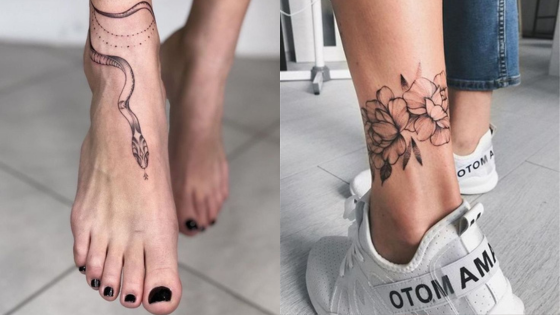

UV tattoos are a unique form of body art that glow under ultraviolet light. These special tattoos use ink that reacts to UV rays, making them invisible in normal light but visible when exposed to black light. UV tattoos offer a discreet option for those who want body art without the everyday visibility of traditional tattoos.
The concept of UV tattoos gained popularity in the early 2000s. They appeal to people who want to keep their tattoos hidden at work or in certain social settings. UV tattoos also attract those who enjoy the surprise factor of artwork that only appears in specific lighting conditions.
While UV tattoos may seem exciting, it’s important to consider the pros and cons before getting one. The long-term effects of UV ink on the body are not fully known. Some people may experience allergic reactions or other skin issues. It’s crucial to find a skilled artist who uses high-quality, safe inks for UV tattoos.
Key Takeaways
- UV tattoos glow under black light but remain invisible in normal lighting
- The long-term effects of UV ink on the body are not fully understood
- Finding a skilled artist and using high-quality inks is crucial for UV tattoos
History of UV Tattoos


UV tattoos first appeared in the 1990s. They use special inks that glow under ultraviolet light but are invisible in normal light. This new style caught on quickly with ravers and club-goers.
Early UV inks had safety concerns. Some contained phosphorus, which can be toxic. This led to health warnings and bans in some areas.
In the 2000s, tattoo artists worked to create safer UV inks. They developed new formulas without harmful chemicals. These improved inks helped UV tattoos gain more acceptance.
UV tattoos became popular for subtle designs. People could hide them during the day and show them off at night. This appealed to professionals who wanted tattoos without workplace issues.
By the 2010s, UV tattoos were more common. Improved inks and techniques made them safer and longer-lasting. Artists began creating more complex UV designs.
Today, UV tattoos are still a niche form of body art. They remain popular in nightlife scenes and among tattoo enthusiasts. Ongoing research aims to make UV inks even safer and more durable.
Understanding UV Tattoo Ink
UV tattoo ink is a special type of ink that glows under ultraviolet light. It’s made of unique chemicals that react to UV rays. This ink comes in different colors and styles.
Composition
UV tattoo ink contains fluorescent dyes. These dyes absorb UV light and emit visible light. The main ingredients are phosphors and fluorescent pigments. Some inks use organic compounds, while others use synthetic materials.
UV inks don’t have metal-based pigments like regular tattoo inks. This makes them less likely to cause allergic reactions. The exact formula varies by brand and color.
Varieties
UV inks come in many colors. Clear UV ink is popular because it’s invisible in normal light. It only shows up under UV light. Other colors include blue, green, pink, and yellow.
Some UV inks are semi-visible. They have a faint color in daylight but glow brightly under UV light. Artists can mix UV inks with regular tattoo ink for unique effects.
UV ink quality varies between brands. High-quality inks last longer and glow brighter. Cheaper inks may fade faster or lose their glow over time.
Health and Safety Considerations
UV tattoos come with unique health and safety factors to consider. These include potential skin reactions, regulatory issues, and special aftercare needs.
Skin Reactions
UV tattoos can cause allergic reactions in some people. The ink used contains chemicals that may irritate sensitive skin. Common symptoms include redness, swelling, and itching. In rare cases, more severe reactions can occur.
Some individuals report a burning sensation when their UV tattoos are exposed to sunlight. This happens because the ink absorbs UV light. The effect is usually temporary but can be uncomfortable.
Long-term effects of UV tattoos are not fully known. More research is needed to understand potential risks over time.
Regulation and Approval
UV tattoo inks are not approved by the FDA for use in humans. This means they haven’t been tested for safety or long-term effects. Many countries have no specific rules for UV tattoos.
Tattoo artists may not have proper training with UV inks. This can lead to poor quality work or unsafe practices. It’s important to choose an experienced artist who understands UV tattoo techniques.
Some places ban UV tattoos due to safety concerns. Check local laws before get*ting one.
Aftercare
UV tattoos need special care to heal properly. Keep the tattoo clean and moisturized. Avoid soaking it in water for the first few weeks.
Protect UV tattoos from sunlight during healing. Wear loose clothing over the tattoo. Apply sunscreen once it’s fully healed to prevent fading.
Watch for signs of infection like increased pain or pus. See a doctor if these occur. Avoid picking at scabs or peeling skin.
Follow all aftercare instructions from your tattoo artist carefully. This helps ensure proper healing and reduces risks of complications.
UV Tattoo Process


Getting a UV tattoo involves several key steps. The process requires careful planning and skilled application to create a unique glowing design.
Consultation
The UV tattoo journey starts with a consultation. A client meets with the artist to discuss ideas and goals. The artist explains how UV ink works and its special features. They talk about design options that look good under black light. Safety concerns and aftercare are also covered. The artist checks for any allergies or skin issues. This helps ensure the tattoo will be safe and successful.
Designing
Next comes the design phase. The artist creates a custom design based on the client’s wishes. They may draw it by hand or use computer software. The design is adjusted to work well with UV ink. Some parts may glow while others stay invisible. The artist makes sure the design will show up clearly under black light. They also consider how it will look in normal lighting.
Application
The actual tattooing process begins with cleaning the skin. The artist puts on gloves and sets up their equipment. They transfer the design onto the skin. Using a special tattoo machine, they inject UV ink into the skin. The process can take longer than regular tattoos. The artist must work carefully to get the right depth and coverage. Clients can’t see the full effect until it’s done and under black light. The artist checks their work with a UV lamp as they go.
Visibility and Aesthetics


UV tattoos have unique visual properties that change based on lighting conditions. Their appearance shifts dramatically from day to night.
Under Daylight
UV tattoos are nearly invisible in normal light. They blend in with the skin, showing only faint outlines or slight scarring. This makes them ideal for people who want hidden tattoos.
Some UV inks leave a pale white or light pink mark on the skin. These subtle traces can be covered with makeup if needed.
The discreteness of UV tattoos appeals to professionals who need to maintain a conservative appearance at work. It also suits those who prefer private body art.
Under UV Light
UV tattoos come alive under blacklight. They glow brightly in vibrant colors like blue, purple, and green. The designs appear to float on the skin’s surface.
The glowing effect creates a striking contrast against regular tattoos. This allows for creative layering of visible and UV elements in tattoo art.
UV ink colors are more limited than regular tattoo inks. But artists can still create intricate glowing designs. Popular choices include geometric patterns and nature-inspired motifs.
The glow intensity varies based on ink quality and healing. Proper aftercare helps maintain the brightness of UV tattoos over time.
Popularity and Cultural Significance


UV tattoos have gained popularity in recent years. These glowing designs appeal to people who want unique body art. They’re especially common among club-goers and ravers.
Many see UV tattoos as a way to express themselves. The hidden nature of these tattoos attracts those who prefer subtle artwork. Some choose UV ink to add secret details to regular tattoos.
Fashion and beauty influencers have helped spread interest in UV tattoos. Social media posts showing glowing designs under blacklights have sparked curiosity. This has led more people to consider getting UV ink.
UV tattoos hold different meanings for different groups. Some view them as a fun party trick. Others see them as a form of self-expression. In certain subcultures, they’re seen as a mark of belonging.
The popularity of UV tattoos varies by region. They’re more common in areas with active nightlife scenes. Cities known for electronic music festivals tend to have higher rates of UV tattoos.
Despite growing interest, UV tattoos remain less common than traditional ones. Some people worry about potential health risks. Others prefer the look of regular tattoos. Still, UV ink continues to attract those seeking something different.
Professional Considerations for Tattoo Artists


Tattoo artists working with UV inks face unique challenges. They need special skills and tools to create these glowing designs safely and effectively.
Training
UV tattoo artists need extra training beyond standard tattooing. They must learn about UV ink chemistry and how it reacts with skin. Artists should study proper UV ink application techniques. This includes using the right needle depth and speed.
Safety is key when working with UV inks. Artists must know how to prevent ink contamination. They should also learn to spot potential allergic reactions in clients. Many artists take special courses on UV tattooing to gain these skills.
Equipment
UV tattoo artists require special equipment. They need UV lights to see their work as they tattoo. These lights help ensure even ink distribution and proper color saturation.
Sterilization tools are extra important for UV tattoos. Artists must use autoclaves to clean all equipment thoroughly. They should have separate tools for UV inks to prevent mixing with regular inks.
UV-blocking eyewear protects both artist and client during the process. Special aftercare products help UV tattoos heal properly. Artists should stock these items and educate clients on their use.
Cost and Maintenance
UV tattoos typically cost more than regular tattoos. The price ranges from $50 to $200 per hour of work. A small UV tattoo might cost $100-$300, while larger designs can cost $500 or more.
The higher cost comes from special UV-reactive ink and the artist’s expertise. Not all tattoo artists offer UV tattoos, so finding a skilled professional may take time.
UV tattoos need regular touch-ups to stay visible under black light. The ink can fade faster than regular tattoo ink. Most people need touch-ups every 1-3 years, depending on factors like:
- Skin type
- Sun exposure
- Aftercare routine
Proper aftercare is crucial for UV tattoos. This includes:
- Keeping the tattoo clean and moisturized
- Avoiding sun exposure
- Using sunscreen when outdoors
Regular check-ups with a dermatologist are recommended to monitor for any skin reactions. Some people may develop allergies to UV ink over time.
It’s important to budget for both the initial cost and long-term maintenance of a UV tattoo. The ongoing expenses can add up over the years.
Removal and Fading
UV tattoos can be tricky to remove. Unlike regular tattoos, they don’t show up under normal light. This makes it hard for laser removal technicians to target the ink.
Some people report UV tattoos fading faster than regular ones. The special ink may break down more quickly in the skin over time.
Laser removal can work on UV tattoos, but results vary. Multiple sessions are often needed. The process can be expensive and may not remove the tattoo completely.
Natural fading happens as the body breaks down the ink. UV tattoos might fade faster in people who spend lots of time in the sun.
Factors affecting UV tattoo fading:
- Ink quality
- Tattoo depth
- Skin type
- Sun exposure
- Age of tattoo
Cover-ups are another option. A darker, regular tattoo can be placed over the UV design. This hides the glowing effect under black light.
It’s important to think carefully before getting a UV tattoo. Removal can be challenging and may not give perfect results.
Innovations and Trends in UV Tattoos


UV tattoos have come a long way since their early days. Artists now use special inks that glow under black light but stay invisible in normal light.
New techniques let tattooists create more detailed and colorful designs. Some UV inks even change colors when exposed to different light wavelengths.
Safety has improved too. Modern UV inks are made with safer ingredients that reduce the risk of allergic reactions.
Here are some popular trends in UV tattoos:
- Glow-in-the-dark body art for nightclubs and festivals
- Hidden messages that only show up under black light
- Accent pieces that highlight regular tattoos
- UV-reactive hair dye that glows in the dark
Artists are experimenting with UV ink in other fields too. Some use it for temporary festival markings or glow-in-the-dark face paint.
Researchers are looking into medical uses for UV ink. They’re testing ways to use it for marking radiation treatment areas on cancer patients.
As UV tattoo technology advances, we can expect to see even more creative and practical applications in the future.
- 9shares
- Facebook0
- Pinterest8
- Twitter1
- Reddit0













